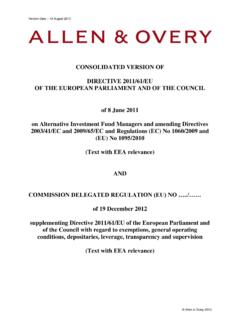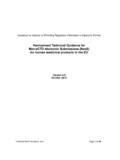Transcription of MHRA GMP Data Integrity Definitions and Guidance for ...
1 MHRA GMP data Integrity Definitions and Guidance for Industry March 2015 Introduction: data Integrity is fundamental in a pharmaceutical quality system which ensures that medicines are of the required quality. This document provides MHRA Guidance on GMP data Integrity expectations for the pharmaceutical industry. This Guidance is intended to complement existing EU GMP relating to active substances and dosage forms, and should be read in conjunction with national medicines legislation and the GMP standards published in Eudralex volume 4. The data governance system should be integral to the pharmaceutical quality system described in EU GMP chapter 1. The effort and resource assigned to data governance should be commensurate with the risk to product quality, and should also be balanced with other quality assurance resource demands.
2 As such, manufacturers and analytical laboratories are not expected to implement a forensic approach to data checking on a routine basis, but instead design and operate a system which provides an acceptable state of control based on the data Integrity risk, and which is fully documented with supporting rationale. data Integrity requirements apply equally to manual (paper) and electronic data . Manufacturers and analytical laboratories should be aware that reverting from automated / computerised to manual / paper-based systems will not in itself remove the need for data Integrity controls. This may also constitute a failure to comply with Article 23 of Directive 2001/83/EC, which requires an authorisation holder to take account of scientific and technical progress and enable the medicinal product to be manufactured and checked by means of generally accepted scientific methods.
3 Throughout this Guidance , associated Definitions are shown as hyperlinks. Establishing data criticality and inherent Integrity risk: In addition to an overarching data governance system, which should include relevant policies and staff training in the importance of data Integrity , consideration should be given to the organisational ( procedures) and technical ( computer system access) controls applied to different areas of the quality system. The degree of effort and resource applied to the organisational and technical control of data lifecycle elements should be commensurate with its criticality in terms of impact to product quality attributes. data may be generated by (i) a paper-based record of a manual observation, or (ii) in terms of equipment, a spectrum of simple machines through to complex highly configurable computerised systems.
4 The inherent risks to data Integrity may differ depending upon the degree to which data (or the system generating or using the data ) can be configured, and therefore potentially manipulated (see figure 1). Withdrawn data Integrity Definitions and Guidance Revision March 2015 2 Figure 1: Diagram to illustrate the spectrum of simple machine (left) to complex computerised system (right), and relevance of printouts as original data (diagram acknowledgement: Green Mountain QA LLC) With reference to figure 1 above, simple systems (such as pH meters and balances) may only require calibration, whereas complex systems require validation for intended purpose . Validation effort increases from left to right in the diagram above. However, it is common for companies to overlook systems of apparent lower complexity.
5 Within these systems it may be possible to manipulate data or repeat testing to achieve a desired outcome with limited opportunity of detection ( stand-alone systems with a user configurable output such as FT-IR, UV spectrophotometers). Designing systems to assure data quality and Integrity Systems should be designed in a way that encourages compliance with the principles of data Integrity . Examples include: Access to clocks for recording timed events Accessibility of batch records at locations where activities take place so that ad hoc data recording and later transcription to official records is not necessary Control over blank paper templates for data recording User access rights which prevent (or audit trail) data amendments Automated data capture or printers attached to equipment such as balances Proximity of printers to relevant activities Access to sampling points ( for water systems) Access to raw data for staff performing data checking activities.
6 Withdrawn data Integrity Definitions and Guidance Revision March 2015 3 The use of scribes to record activity on behalf of another operator should be considered exceptional , and only take place where: The act of recording places the product or activity at risk documenting line interventions by sterile operators. To accommodate cultural or staff literacy / language limitations, for instance where an activity is performed by an operator, but witnessed and recorded by a Supervisor or Officer. In both situations, the supervisory recording must be contemporaneous with the task being performed, and must identify both the person performing the observed task and the person completing the record. The person performing the observed task should countersign the record wherever possible, although it is accepted that this countersigning step will be retrospective.
7 The process for supervisory (scribe) documentation completion should be described in an approved procedure, which should also specify the activities to which the process applies. WithdrawnMHRA Questions and Answers for Specials manufacturer s Revision 1 December 2014 4 data Integrity Definitions and Guidance Revision March 2015 4 In the following Definitions , the term ' data ' includes raw data . Term definition Expectation / Guidance (where relevant) data Information derived or obtained from raw data ( a reported analytical result) data must be: A - attributable to the person generating the data L legible and permanent C contemporaneous O original record (or true copy ) A - accurate Raw data Original records and documentation, retained in the format in which they were originally generated ( paper or electronic), or as a true copy.
8 Raw data must be contemporaneously and accurately recorded by permanent means. In the case of basic electronic equipment which does not store electronic data , or provides only a printed data output ( balance or pH meter), the printout constitutes the raw data . Raw data must: Be legible and accessible throughout the data lifecycle. Permit the full reconstruction of the activities resulting in the generation of the data Withdrawn MHRA Questions and Answers for Specials manufacturer s Revision 1 December 2014 5 data Integrity Definitions and Guidance Revision March 2015 5 Metadata: Metadata is data that describe the attributes of other data , and provide context and meaning. Typically, these are data that describe the structure, data elements, inter-relationships and other characteristics of data .
9 It also permits data to be attributable to an individual. Example: data (bold text) and metadata, giving context and meaning, (italic text) are: sodium chloride batch 1234, J Smith 01/07/14 Metadata forms an integral part of the original record. Without metadata, the data has no meaning. data Integrity The extent to which all data are complete, consistent and accurate throughout the data lifecycle. data Integrity arrangements must ensure that the accuracy, completeness, content and meaning of data is retained throughout the data lifecycle. data governance The sum total of arrangements to ensure that data , irrespective of the format in which it is generated, is recorded, processed, retained and used to ensure a complete, consistent and accurate record throughout the data lifecycle data governance should address data ownership throughout the lifecycle, and consider the design, operation and monitoring of processes / systems in order to comply with the principles of data Integrity including control over intentional and unintentional changes to information.
10 data Governance systems should include staff training in the importance of data Integrity principles and the creation of a working environment that encourages an open reporting culture for errors, omissions and aberrant results. Senior management is responsible for the implementation of systems and procedures to minimise the potential risk to data Integrity , and for identifying the residual risk, using the principles of ICH Q9. Contract Givers should perform a similar review as part of their vendor assurance programme Withdrawn MHRA Questions and Answers for Specials manufacturer s Revision 1 December 2014 6 data Integrity Definitions and Guidance Revision March 2015 6 data Lifecycle All phases in the life of the data (including raw data ) from initial generation and recording through processing (including transformation or migration), use, data retention, archive / retrieval and destruction.














